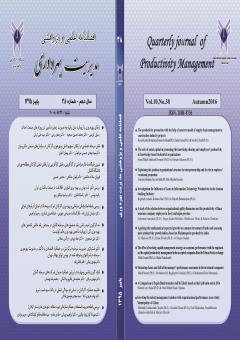اندازه گیری شانس و مهارت در ارزیابی عملکرد مدیران شرکت های سرمایه گذاری
محورهای موضوعی : مدیریت بازرگانیمهدی مرادی 1 , محمدعلی باقرپور ولاشانی 2 , محمدرضا بهمنش 3
1 - دانشیار گروه حسابداری دانشگاه فردوسی مشهد
2 - استادیار گروه حسابداری دانشگاه فردوسی مشهد
3 - دانشجوی دکتری حسابداری دانشگاه فردوسی مشهد و عضو هیات علمی موسسه آموزش عالی عطار مشهد
کلید واژه: ارزیابی عملکرد, شرکتهای سرمایه گذاری, آلفای جنسن, شانس و مهارت,
چکیده مقاله :
در این تحقیق ابتدا کسب بازده مازاد خالص توسط مدیران شرکتهای سرمایه گذاری مورد آزمون قرار گرفته و سپس با استفاده از بازده مازاد خالص، شانس و مهارت در این شرکتها اندازه گیری شده است. معیار اندازه گیری بازده مازاد خالص در این تحقیق، آلفای جنسن می باشد و داده های تحقیق برای 25 شرکت سرمایه گذاری بورس اوراق بهادار تهران طی 36 دوره ماهانه استخراج گردید. پس از تأیید کسب بازده مازاد خالص توسط این شرکتها، آنها بر اساس آلفای جنسن به سه دسته (a<0, a=0, a>0) تقسیم و در نهایت شانس در شرکتهای سرمایه گذاری اندازه گیری شد. نتیجه تحقیق حاکی از این است که در سطح اطمینان 10% انتظار می رود 22% شرکتهای سرمایه گذاری با مهارت باشند، اما تنها 19% از این شرکتها با مهارت و 3% شرکتهای شانسی بوده، در نتیجه شانس، بازده مازاد کسب کرده اند. به طور مشابه در سطح اطمینان 10% انتظار می رود 10% شرکتهای سرمایه گذاری بدون مهارت باشند، اما تنها 7% از این شرکتها بدون مهارت و مابقی شرکتهای شانسی بوده اند.
This study has examined the net yield surplus earned by the investment companies Managers, and using the net yield surplus the chance and skill were also examined.The measurement criterion for net sur plus was Jensen’s Alpha and research data for 25 bourse bonds investment companies of Tehran were extracted during 36 months periods. After the approval of net yield surplus earned by these companies they were devided into three categories based on Jensen’s Alpha (a <0, a = 0, a> 0) and finally chance was measured in the investment companies. The results showed thatin 10 percent level of confidence it is expected that 22 percent of investment companies were considered skillful,but only 19 percent of them were skillful and 3 percent of them were by chance. Similarly, in 10 percent level of confidence the investment companies were without skill, but exactly 7 percent were without skill, the rest of them were by chance.
- Arabmazar Yazdi, M., & Mashayekh, S. (2003), Excess return management professional (active) investment companies, accounting studies ,No. 4, pp:1-24.(In Persian)
- Arabmazar Yazdi, M. & Mashayekh, S. (2005), Functioning investment firms accepted in Tehran Stock Exchange during the period from 1995 to 2001, review of accounting and auditing, No. 42, pp: 41-60. (In Persian)
- Barras, L. Scailet, O. & Wermers, R. (2010), False Discoveries in Mutual Fund Performance: Measuring Luck in Estimated Alphas, journal of finance, Vol. lxv, No. 1, pp: 179-216.
- Behzad, M. (1997), Performance of investment firms in Tehran Stock Exchange, Master of Thesis, Mazandaran University of Science and Technology. (In Persian)
- Courd bacheh, H., Hozoori, M. J. & Malmir, A.(2012), Assessment of risk-adjusted performance relative to mutual funds in Iran, Journal of Research and Economic Policy, No. 63, pp:51-82. (In Persian)
- Cremers. M. & Petajisto, A. (2009), How Active is Your Fund Manager? A New Measure That Predicts Performance. www.ssrn.com
- Esmaeili, R.(1998), Risk analysis and stock returns of investment in Tehran Stock Exchange, Master of Thesis, University of Tehran. (In Persian)
- Eslami, B., Reza Tehrani, G. & Shirazian, Z. (2005), The relationship between investment firms' performance based on three criteria trainer, Jensen, Sharp size (market value) and liquidity, Financial Research, No. 19, pp: 3-24. (In Persian)
- Investment Company Institude (2003), Mutual Funds Fact Book. www.ici.org.
- Jabbari, R., Salehi Sadaghiani, J. & Amiri, M. (2012), Portfolio performance evaluation and selection of investment fund shares, Journal of operations Research and its applications,No.32, pp:1-19 (In Persian)
- Jensen. M. C. (1968), the performance of mutual funds in the period 1945-1964,
- Journal of Finance, Vol. 23, No. 2 ,pp: 389-416.
- Kosowski. R., Timmermann, A. Wermers, R. & White, H. (2006), Can Mutual Fund “Stars” Really Pick Stocks? New Evidence from a Bootstrap Analysis, journal of finance, Vol. lxv, No. 6, pp:2551-2595.
- Moradian Boroujeni, P., Fereiduni, S. & Zare Mehrjardi, Y. (2010), Providing simulated annealing method based on fuzzy programming model a chance to budgeting issues, International Journal of Industrial Engineering & Production Management, No. 3, pp: 94-101. (In Persian)
- - Malkiel. B. G. (1995), Returns from investing in equity mutual funds 1971 to 1991, Journal of finance, vol. 50, issue. 2, pp: 549-572.
- Sharpe, W. F., Alexander, G. J. & Bailey, J. V. (1999), Investment, Sixth Edition, New Jersy: Prentice-Hall.
- Saeedi, A. & Moghaddasian, E. (2010), evaluating the performance of fund equity investments in Iran, Journal Stock Exchange, No. 9, pp: 5-24. (In Persian)
- Tehrani, R., & Bajelan, S. (2009), Relationship between firm characteristics and financial success, Journal of Executive Management, No, 33, pp: 77-102. (In Persian)


